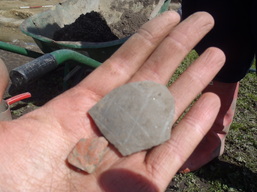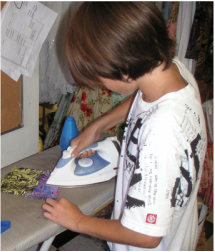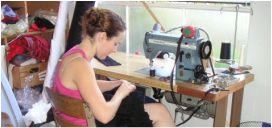Vindolanda - roman fort and settlement in northern england

I am a tremendous fan of archaeology and the study of material culture. These are some of the only sources of information we have on some underrepresented populations in history. Anyone who did not write things down was either left out of the historical narrative, or only included in the words of others and so for groups like women, slaves, and just regular, but illiterate people, looking at the objects that they used can tell us more about their lives. They no longer have to remain invisible.
I volunteered at Vindolanda in Northumberland on an archaeological dig in the summer of 2012. One of the most prolific sites of first century artifacts in the world, it was an incredible way to actually TOUCH history. Daily digging up pottery shards and bones and even preserved twigs and imagining that you are the first person to touch that object in two thousand years is incredibly exciting! I hope to be able to bring a group of students with me to have an experience like this someday. But until then, anyone can sign up on their website: <http://www.vindolanda.com/excavate>
I volunteered at Vindolanda in Northumberland on an archaeological dig in the summer of 2012. One of the most prolific sites of first century artifacts in the world, it was an incredible way to actually TOUCH history. Daily digging up pottery shards and bones and even preserved twigs and imagining that you are the first person to touch that object in two thousand years is incredibly exciting! I hope to be able to bring a group of students with me to have an experience like this someday. But until then, anyone can sign up on their website: <http://www.vindolanda.com/excavate>
Learning through playing games and teaching each other
Playing games is a great way to learn, but MAKING games is even better! The slideshow above is created from photos of student projects in my grade 12 Economics class at SPHS. Students were to make a board game, story book or text book of their own which illustrated concepts that they had mastered in the course. When the projects were complete, students were able to play each other's games, and read the books they had created. You would think students today would want to do only digital projects, but the hands-on, three-dimensional qualities of this project seemed to be part of the fun.
theatrical sewing
|
Also at CSDC in the summers, I teach students to make their own clothing for the historical characters they portray in their shows. Students' experiences in making simple dresses and pants helped them to bring together skills from several parts of their academic experience. Accurate measuring and cutting are difficult for some, mostly because they run out of patience to do it right. Then later in the project when the seams inevitably do not match up, they learn in a very real way the value of not taking shortcuts, and managing their time. Last June, one girl made the same pair of pants and took them apart three times over before she got them right. This hands-on experience with a frustrating and daunting task was new for many of the CSDC students who were accustomed to more traditionally academic projects.
|
learning about manners in the past

A few years ago a "Father-Daughter" collaboration took place at CSDC. It was an opportunity for female students to teach their fathers' a new skill. Historical dance styles, and rules of behavior were explored in a project where students and their adult relatives, worked together to recreate a ball from the Victorian Era. The girls who dressed in hoop-skirts learned about conspicuous consumption and the ways in which fashion can change your behavior and the way people interact. Some students volunteered to help construct the dresses, and quickly became frustrated with the tedium of creating dozens of yards of ruffles! The project overall helped students to appreciate how behavior norms are linked to the historical period they are formed in. They learned how much labor went in to creating the beautiful dresses of the nineteenth century, and they had a chance to teach an adult what they had learned.


